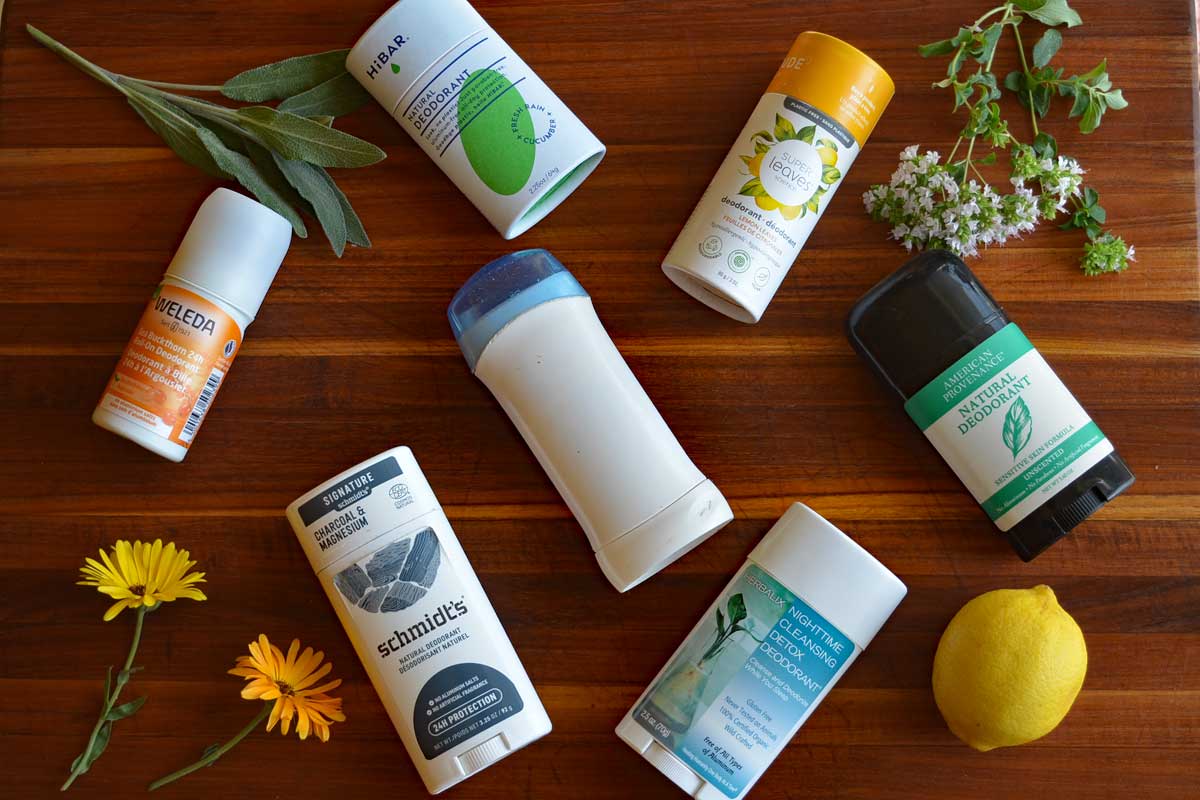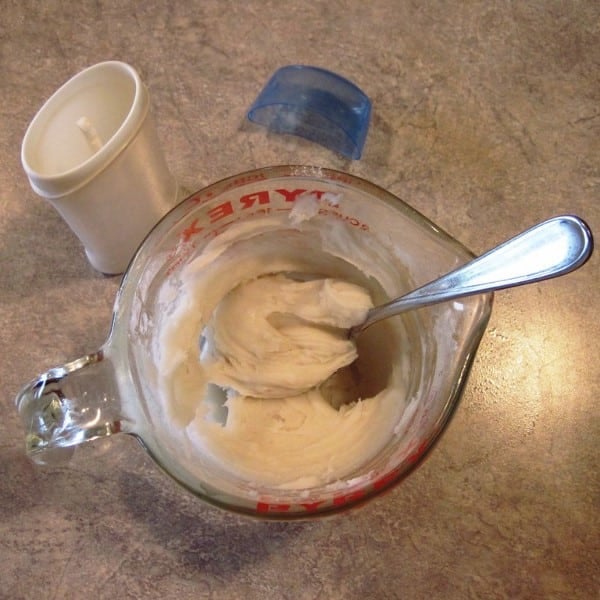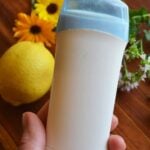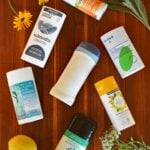Easy Homemade Deodorant & The Best Natural Deodorants
This post may contain affiliate links. Read my full disclosure here.
The aluminum and other chemicals in store bought deodorants have been linked to breast cancer. As a healthier alternative, we’re sharing an easy homemade deodorant recipe, plus our choices for best natural deodorants.

Health Concerns with Conventional Deodorants and Antiperspirants
Like many beauty products, mainstream deodorants often contain questionable ingredients. Some of these include:
Aluminum Compounds (in antiperspirants) – There is a disproportionate amount of breast cancer in the upper outer quadrant – next to your armpits. Aluminum can cause DNA alterations. That’s reason enough for me to choose an aluminum free deodorant.
One study I saw recently indicated that the crystal deodorants may actually be more dangerous than regular deodorants. My grandmother battled breast cancer, and I lost my older sister to cancer, so I’ve been working to detox our home, diet and our personal care products.
Aluminum salts temporarily block sweat glands to reduce sweating, which may interfere with the body’s natural detoxification.
Parabens – Parabens (used as preservatives) mimic estrogen, which may trigger hormone disruption.
Synthetic Fragrances – Many deodorants use synthetic fragrances, which may contain allergens or endocrine disruptors like phthalates. These contribute to hormone imbalances and skin irritation. They also stink – at least to me. My son is so sensitive to synthetic fragrances that he had to give up jiu jitsu because he got sick from close contact with chemical deodorants and detergents.
Skin Sensitivity – Some ingredients, such as triclosan (a common antibacterial agent), can cause irritation or allergic reactions. Triclosan disrupts the skin microbiome and thyroid function. With my sensitive skin, I used to break out in hives from some deodorants.
Easy Homemade Natural Deodorant Recipe
This simple homemade deodorant uses coconut oil, baking soda, tapioca starch, and essential oils (optional).
To make the homemade deodorant, in a small bowl, combine:
- 1/4 cup baking soda
- 1/4 cup tapioca starch
Mix in 4 – 6 Tablespoons of softened coconut oil or shea butter. Add a few drops of essential oil, if desired. This creates a soft paste that’s easy to spread on the skin.

You can keep this mixture in a small glass jar and apply with your fingertips, but it’s much easier to use an old deodorant container. You can also buy new empty deodorant containers. The trickiest part of the whole process is loading it in the tube.
Alternatives to tapioca starch:
- Corn starch (look for non-GMO)
- Arrowroot powder
Need a baking soda free deodorant? Skip the baking soda and reduce the coconut oil accordingly. If you want a milder fragrance, infuse your coconut oil with herbs before making homemade deodorant. Learn how to infuse herbs here.

Would you like to save this?
It’s best to keep this homemade deodorant in the refrigerator when it gets hot, as it will get soft. Shea butter will stay firmer than coconut oil. There’s a chance it might stain light colored clothing, due to the oil, but I didn’t have a problem.
Best Natural Deodorants
Before I list our picks for best natural deodorants, I want to mention that I now rarely wear deodorant. Body odor acts as a diagnostic tool. As long as I eat clean, stay active, and don’t get too stressed out, my body odor is mild. If I’m stinky, I know I need to change up my routine.
Strong body odor may be linked to health issues, diet, synthetic fabrics, medications and supplements, stress, or other factors. If you don’t smell right, see if you can find an underlying cause rather than simply covering it up.
My top pick is Schmidt’s Natural Deodorant with charcoal and magnesium. It absorbs odors, and adds magnesium. Low magnesium levels may contribute to body odor, so this product helps treat the cause of odor.
Herbalix deodorants smell good enough to eat, and provide long lasting protection. In addition to standard deodorants, they also offer detox deodorants. You wear the detox deodorant at night to help clear your armpit pores and lymphatic pathways near the armpits.
Duncan likes Weleda Sea Buckthorn roll on deodorant. He says it goes on smoothly and does not irritate his sensitive skin.
American Provenance Sensitive Skin Formula has a vey short ingredient list, close to the homemade deodorant. It also includes magnesium, and beeswax for a firmer product.
HiBAR natural deodorant has a silky smooth finish and includes magnesium. The packaging is plastic free.
Attitude Super Leaves deodorant also has a plastic free container and pleasant scent. The container is a little more awkward to use than the HiBAR container.
Other Natural Odor Control Options
Use Milk of Magnesia as a Deodorant, as discussed at Whole Natural Life.
Rub a slice of lemon under the armpit to kill odor causing bacteria. (Don’t use this on freshly shaved armpits!) My friend, Mary Jean, likes this option.
A spritz of rubbing alcohol, with or without a drop or two of essential oil and/or witch hazel added. (Again, not a good one to used on freshly shaved armpits.)
Use baking soda or cornstarch alone, applied with a powder puff under the arm
Rub plain coconut oil in the armpit area. Use sparingly and let sit a bit before getting dressed to give the oil a chance to absorb and reduce the chance of staining. Coconut oil is antibacterial and antifungal.
Kristan M. suggests, “It’s as simple as all get out (and I sweat like a butcher)- 1/3 c. organic corn starch. 1/3 c. baking soda. Add seven drops of tea tree oil. Put it in one of those funny looking flat 1-cup Mason jars, and shake it! Apply after showering/bathing with a blush pad.”
Eat some sprouted fenugreek seeds in your salad. Just a small amount per day will make your armpits smell like maple syrup.
What’s under your arms? Leave a comment below to share your thoughts and tips for body odor.

This article was written by Laurie Neverman, engineer by training, health researcher by calling. Disappointed by mainstream advice to “just live with it”, she’s devoted her time to learning more about helping the body to heal. You can read more about how she cleared her skin of psoriasis in her book, “Psoriasis Healing“.
Originally posted in 2011, updated in 2024.






Many moons ago, when the Internet was young, a friend asked me to research “aluminum” for him. When I did, the article talked about “the aluminum in your antiperspirant”!!! I was shocked and stopped using antiperspirants after reading about all the problems aluminum causes the human body. So I’ve been using “deodorant”, since it is only the antiperspirant that uses toxic aluminum. The aluminum stops the sweat, while deodorant masks odor.
Later I had a boyfriend who said he had a problem with keeping a job since he gets real skanky when he sweats and he usually walked to work. My immediate response was “Stop eating spice food.” The spices have to leave the body somehow, I thought. He did and his B.O. drastically reduced.
Hope these thoughts help someone.
Different foods (not just spicy foods) can influence body odor, so that’s certainly something to keep in mind when dealing with excessive body odor.
Hi, Laurie! I make my own deodorant and body powder, but I don’t add any oily stuff. It’s just powder and I keep them in containers with powder puffs to apply. Here they are:
Homemade Body Powder: 3 parts cornstarch or arrowroot powder (I split this between the 2), 1 part baking soda, mix and use.
Homemade Deodorant Powder: Cornstarch/arrowroot powder, baking soda (measure same amounts of both), I add dried lemongrass powder (I grow it and grind it to a powder) for a nice, faint aroma and lemongrass also has healthful properties. You can also add ground lavender, but I’m not crazy about the smell of lavender.
Enjoy!
I have used these products for years with excellent results.
I’m with you on lavender. A little is okay, but I don’t want to smell it all day.
Lime juice works wonders as a deodorant. Fresh or bottled, just rub it in until dry. Stings a bit on freshly shaved skin but not badly. Doesn’t irritate the skin or stain 🙂
Do be careful with lime juice if you will be exposing your armpits to the sun, as it can cause phytophotodermatitis.
I used corn starch, baking soda and coconut oil. I melted those three ingredients and mixed a few drops of grapefruit essential oil in and poured it in a old deoderant container. I’m a nurse and am constantly moving, and I have not had a problem with sweating or smelly armpits. (I keep my deodorant in the fridge as I live in a warmer climate and sometimes room temp. is 90°, coconut oil melts if it is warmer than room temp.)
Hi. I came upon your website tonight and saw the homemade deoderant recipe. I’ve tried this exact recipe before and i started getting little bumps and rash in my armpits during use. I stopped using it for a while and the bumps went away. I made another batch using only half the amount of baking soda and started using again. Again, the bumps came and they are itchy. Is this something I should not try anymore, or is this a way my body is detoxing? It makes me nervous when bumps show up every time I use the homemade deoderant. What do you think of this?
It’s hard to say without seeing it, but it sounds more like simple irritation than detox. When I’d get what I suspect was a detox reaction, it would just be a simple pimple or a large pimple/cyst thing. No itching or irritation to speak of, and once it cleared, it cleared. I’d probably try a different option.
An herbalist friend says she uses baking soda only. I had made the cornstarch/soda/coconut oil mixture, but her suggestion for the baking soda intrigued me. I had trouble with it initially causing bumps, but the slight abrasiveness looks like it was the problem. Now I shave at night, then apply the baking soda in the morning, patting in on – but not rubbing it at all. I have been odor free for months now.
Just bought Lavilin for the first time. Excited to experiment with it. Heard Lavilin is the best one! I will try it in combination with your tips and let you know how it goes.
Sounds good.
Hi, just wondering if the above recipe goes on feeling sticky? I have tried more natural deodorants (Toms of Maine in particular) and it feels sticky. Yuck, I think I would rather just be sweaty than sticky. Also, I don’t have a lot of free time, so other than Herbalix, any other deodorants that I can buy that are safer. (Natural as opposed to conventional.) Thanks!
I’m still using Herbalix when I’m not using homemade, so I haven’t really experiment with other options. This recipe goes on smooth, not sticky.
I just placed my order! I’m excited to try these products. I’m long overdue for this detox. I’m hoping that by some miracle, after a full round of the large (go big or go home) night detox deodorant and day application, the amount and frequency of my perspiration will decrease. Perhaps my body has been over compensating all these years due to toxins overload…? We’ll see:)
What I notice is that eating clean reduces my armpit smell a high percentage. I’ve been able to take care of residual odor (especially when sweating) by drinking a few swigs of mint flavor liquid chlorophyll.
I was so thankful that a friend gave me these recommendations and they work for me. My armpits have in the past smelled so awful that I’ve had to wash and re-apply deodorant several times a day. Embarrassing as well as unhealthy (because I was using conventional deodorant).
I was also one who tried the deodorant crystal (both the solid form and the liquid form) and it didn’t work for me. I’ve also tried many brands of “natural” deodorants that have either not helped with odor or smelled worse than my arm pits. (Maybe it was a chemical reaction between my body and the deodorant.)
Having said that, I AM interested in trying the Herbalix for my daughter. None of the other “natural” deodorants have worked for her and she isn’t consistent with the liquid chlorophyll…
Thank you for sharing so much detail with us!
Diet has a HUGE influence on body odor. We found out the fun way with the fenugreek sprouts, but I’ve also found the not so pleasant option when I’ve eaten something I probably should have not. Be aware that the Herbalix Detox deodorant may make a person smell worse before they smell better.
Haven’t used anything except water and a washcloth now for nearly 10 years – any change in diet/health can affect the smell of sweat so monitor your body that way – too many of my friends suffered cancers that could be linked to blockages from deodorant chemicals.
I was just wondering. I signed up to receive your posts by email as I am trying to cut down my “facetime” on Facebook. I saw this article posted on Facebook, but I haven’t received it in the email? Will I not receive all your posts via email?
Deitra – you will receive all new posts by email, but each day I try to share one or more older posts on Facebook for those who are new to the site. This post was originally published in 2011.
I actually don’t normally wear deodorant. If I notice a slight smell, I just wash my pits. As mentioned, diet can play into personal odors.
I recently started making my own deoderant too. I just mix rubbing alcohol, tea tree essential oil, and maybe one more if I want a prettier scent. I like the spray bottle too, then it doesn’t go on too thick. If I find myself getting too sweaty I just splash a bit of rubbing alcohol on a piece of cotton and wipe the areas that the smelly bacterial like to hide in.
Hey! I’ve tried a recipe similar to this and it was far too grainy and did absolutely nothing for me. I also don’t like the idea of my body soaking up all those different powders and things (although they are much less harmful than what you would buy at the pharmacy). Also, it requires so many damn ingredients lol! I go for the simplest possible things which has lead me to a mirrrrrracle cure for body odor:
LEMON JUICE!!
(or lime, whatever you have available)
All I do is squeeze the juice out of a lemon, strain it, and put it in a spray bottle. Two lemons gives you enough for 1-2 months of deodorant (although it does start to smell funky after a couple works, the scent doesn’t linger and it works perfectly in preventing stink). I just spray it 4 times on each pit and let it dry for a while before putting my shirt on in the morning. This works amazingly, my sweat has literally no smell (and I checked with family members who can attest to the fact that my body odor doesn’t smell at all!). However, *WARNING IF YOU’RE GOING TO TRY THIS (which you absolutely should)* it can sting sharply if you have a cut from shaving, so be careful! But it only stings for like, 1 minute, then goes away.
Just my two cents 🙂 Just found your blog and quite enjoy reading it!
*after a few weeks, not works aha
My friend, MJ, uses lemon juice, too. I’ve been a little leery to try it since I often shave before applying deodorant. 🙂
I’ve been using alcohol for… gosh, only a few months now. Found the skinny on using and making it here: http://www.diynatural.com/natural-homemade-deodorant/
Yes, I add essential oils to it. No problems with razor burn, although I do usually shave my pits before sleeping, to give the skin time to rest before coating it with anything. But having read the comments here, I might add putting a bit of coconut oil on before sleeping, too. Sounds quite workable, and might be even more pleasant. Certainly more pleasant-smelling.
Cher – thanks for chiming in. I’ve been working to increase my magnesium intake, too, which also affects body odor.
I have used the above recipie for several years and LOVE IT!! No staining on my clothes and I use my coconut oil after if sits in the sun for about 5 mins to soften. WORKS GREAT!!
My youngest has taken to using this now. He likes it because it’s mild but works.
Thank you so much for this. There are two things I miss living toxin free. A big gnarley cheese burger and good deoderant. Now I have something new to try. 🙂
Becca.
Oooooo…big, gnarly cheeseburgers…. 🙂
back in the 90s, a friend first turned me onto the idea that humans, and all animals are predominately ‘self-cleaning’ with a little water and scrubbing (which for some animals is licking…others, a washcloth…or just hands…).
i know…shocking, right?!
around that time, i shaved my head. i’d always used shampoo and conditioner, and had recently been aware of all the toxics in many brands, so had upgraded to mucho expensive brands. when my hair was only a 1/4 inch, all i did was rub my hands across it in the shower. as my hair grew out, i rarely used shampoo, and even less rarely, conditioner. My hair was always clean!
About 10 years ago, I met a woman in her 40s with long gray hair, about ½ way down her back. Her shampoo recipe? Hot water in the shower, scrubbing with her hands. That was another mindblower because I’d thought that I could only get away with ‘water shampoo’ because my hair was short. Seems anybody can wash their hair with water!
About the only time I’ll use soap or shampoo on my hair now is when I’ve been exposed to something toxic—like insulation, asbestos, chemical fumes (not sure that water wouldn’t be as effective)—or when I’ve been exposed to poison ivy. I know that soap helps break down those oils when water won’t.
Finally she gets to the pits. I’ve mostly not worn deodorant for 10 or more years. The 10 or more years before that I bought the ‘natural’ stuff. The only time I worry about it now is if I have extended corporate office time. Last time that happened, I made a ‘ball’ of coconut oil by softening it, then making a ball maybe 1.5-2x the size of a golf ball (huge hush puppy!), which I then stored in the frig.
Coconut oil is antibacterial which kills the critters that smell up our pits in ways that some find offensive (I used to be offended to, but now I tend to love the natural healthy smells of people). I used it at nite so it was soaked in my the morning (less problems with oil stains on my ‘downtown’ clothes). Love it! I think taking coconut oil internally can help with body odor too.
Ive been using the baking soda, and cornstarch for about a year now. But i just add water and a few drops of lavender oil, and store it in a closed jar. Its great. I use a soft toothbrush, to apply, or you could try a tiny makeup brush.
I'll be waiting to hear how it goes. Still detoxing. 🙂
I just whipped up a batch of this using grapefruit essential oil for a scent/antibacterial. Will let you know how it works out. The coconut oil was a little soft because of the heat and it only took me three tablespoons. I put it in the fridge to stiffen up a bit.
I use the same basic ingredients, but in a different way. I just spread a thin layer of coconut oil under my pits, then using a powder puff, pat on the mixture of 1/2 baking soda and 1/2 cornstarch. Mine has a few drops of tea tree oil and some lavender oil added. I actually made it through student teaching without stinking too much, using this deodorant!
The study said "Crystal Natural Deodorant", so I'm assuming it is this product or a similar one: http://www.thecrystal.com/
What do you mean when you say 'crystal deodorants'?
Eleanor – thanks for sharing that information – very good to know. Any other suggestions for thickening? The Herbalix products are specifically geared towards detox/improving health, but I know not everyone has a budget that will allow their purchase.
I have seen a lot of these recipes on line. They all use corn startch or arrow root as a thickener. However, for diabetics this is not good, as they can get yeast infections in their arm pits and these carbohydrates feed the yeast. My DH has to have his dress shirts not starched for this very reason. Trust me, it was pretty icky.
I'm looking forward to seeing a review of how this works.